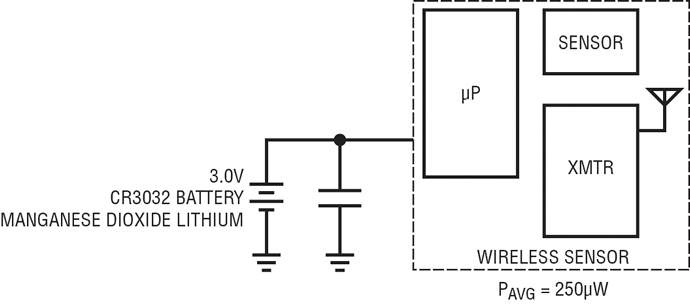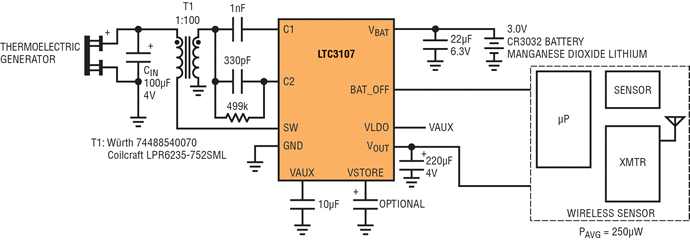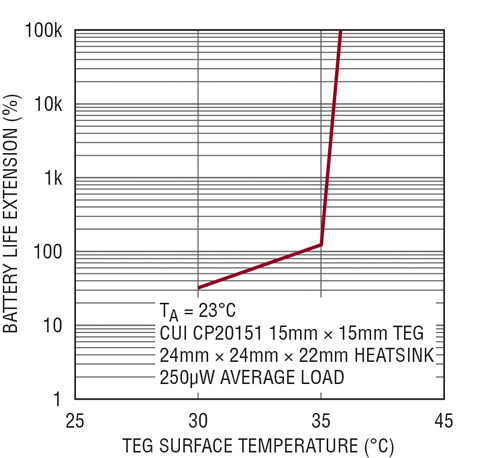Thermal energy harvesting helps extend battery life
Energy harvesting can significantly extend the lifetime of installed batteries, especially when power requirements are low, reducing long term maintenance costs and down-time. Dave Salerno, Design Section Leader, Power Products, Linear Technology Corporation explains.
Wireless and wired sensor systems are often found in environments rife with ambient energy, which is ideal for powering the sensors themselves. For instance, energy harvesting can significantly extend the lifetime of installed batteries, especially when power requirements are low, reducing long term maintenance costs and down-time. In spite of these benefits, a number of adoption roadblocks persist.
The most significant is that ambient energy sources are often intermittent, or insufficient to power the sensor system continuously, where primary battery power sources are extremely reliable over the course of their rated life. System designers may be reluctant to upgrade systems to harvest ambient energy, especially when seamless integration is paramount. The LTC3107 aims to change their minds by making it easy to seamlessly extend battery life, by adding energy harvesting to existing designs.
With the LTC3107, a point-of-load energy harvester requires little space, just enough room for the LTC3107’s 3mm × 3mm DFN package and a few external components. By generating an output voltage that tracks that of the existing primary battery, the LTC3107 can be seamlessly adopted to bring the cost savings of free thermal energy harvesting to new and existing battery powered designs.

The LTC3107, along with a small source of thermal energy, can extend battery life, in some cases up to the shelf life of the battery, thereby reducing the recurring maintenance costs associated with battery replacement. The LTC3107 is designed to augment the battery, or even supply the load entirely, depending on the load conditions and harvested energy available.
A digital output, BAT_OFF, is provided to indicate whether or not the battery is being used to power the load at any given time. This allows the system to monitor the effectiveness of the harvester, and the duty cycle of the battery’s usage for maintenance reporting. BAT_OFF is internally pulled up to VOUT.
Figure 1 (above) shows a typical wireless sensor application. This system is powered entirely by a CR3032 3.0V primary lithium coin cell with a capacity of 500mA-Hr. The battery will last about eight months in continuous operation if the average system power demand is 250µW.
Figure 2 (below) shows the same system, using the same battery, with the addition of the LTC3107-based thermal harvester to extend the battery life. Figure 3 (below) shows the predicted battery life extension with the addition of thermal energy harvesting, using a small (15mm × 15mm) thermoelectric generator (TEG) and a 24mm2 heat sink over a range of TEG mounting surface temperatures (assuming a 23°C ambient).

Battery life
In situations where the harvested thermal power is greater than the average power required by the load, the battery is never used to power the load - only 80nA of current is drawn from the battery - resulting in a battery life approaching the five to ten year shelf life of a typical primary battery. Under these conditions, the battery is used only as a reference voltage for the LTC3107 to provide the output voltage regulation target. It is important to note that the LTC3107 prevents any charge current into the battery under all operating conditions.
For example, for the system shown in Figure 2, with the TEG attached to a harvesting heat source, such as a warm pipe or piece of machinery just 12°C above ambient temperature, the LTC3107 can power the 250µW load entirely with harvested energy, resulting in the elimination of many battery service replacements over the shelf life of the battery, as shown in Figure 3.
In situations where no harvested power is available and any stored energy is depleted, the output power is supplied entirely by the battery, just as it was without the harvester, and VOUT is regulated 220mV below the battery voltage. In this case, the harvester circuitry remains idle, adding only 6µA load to the battery.

To protect the battery from short circuits on VOUT, the current from VBATT to VOUT is limited to 30mA minimum and 100mA maximum. Therefore, steady-state loads of at least 30mA can be supported when running from the battery. If needed, higher transient loads can be supported for short durations with the help of the decoupling capacitor on VOUT.
The steady state output current produced by the harvester is dependent on several factors, but is primarily limited by the temperature differential that can be impressed across the TEG. Note that this is not only a function of the TEG mounting surface temperature and the ambient temperature, but by the thermal resistance of the heat sink used on the cool side of the TEG. The harvested output current can range from as little as micro amps to several milliamps steady state. The current that can be supplied to VOUT from VSTORE is limited by the differential voltage between the two pins and the internal path resistance through the LTC3107 charge control circuitry, which is about 120Ω typical. Therefore, the VSTORE current is typically limited to a few milliamps as well, and is not intended to support large load transients. These should be handled by the VOUT decoupling capacitor.
Summary
To facilitate the adoption of thermal energy harvesting into a wide range of new and existing primary battery powered applications, the LTC3107 is designed to work with battery voltages in the range of 2V to 4V. This includes most of the popular long life primary batteries used in lower power applications, such as 3V lithium coin cell batteries and 3.6V lithium-thionyl chloride batteries. The LTC3107 provides the best of both worlds - the reliability of battery power and the maintenance cost savings of thermal energy harvesting with minimal design effort.











